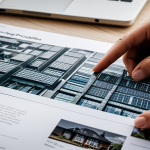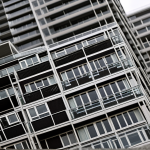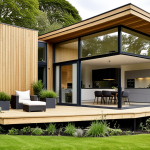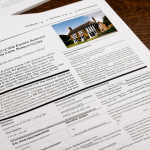Understanding the Green Building Revolution in the UK
Exploring the foundations of sustainable real estate trends
The green building revolution in the UK reflects a profound shift towards sustainability in property development and management. This movement is not merely a trend but a critical transformation driven by environmental concerns, government policies, and consumer expectations. Green building UK initiatives aim to reduce the ecological footprint of buildings by focusing on energy efficiency, resource conservation, and healthier living environments.
Also read : Unique strategies for uk developers to achieve biodiversity net gain compliance
Several factors drive the demand for sustainable properties. Increasing awareness of climate change, rising energy costs, and stricter UK property regulations such as the Energy Performance Certificate (EPC) standards spur both developers and buyers to embrace eco-friendly property movement principles. Furthermore, tenants and homeowners now prefer buildings certified for sustainability, influencing market dynamics.
Key characteristics of green buildings include the use of renewable energy sources, improved insulation, water-saving devices, and sustainable materials. Certifications like BREEAM and LEED serve as benchmarks for green building UK, ensuring that properties meet stringent environmental and performance criteria. By adopting these standards, the UK property market aligns with global sustainable real estate trends, fostering long-term resilience and environmental stewardship.
Also to read : Maximizing your profit: a comprehensive guide to selling inherited property in the uk
Impact of Green Building on UK Real Estate Investment
Sustainability reshaping investor choices and market dynamics
The rise of green building UK has a significant impact on property investment UK, fundamentally altering real estate market trends. Sustainable buildings often command higher property values and improved rental yields, as both tenants and buyers show increasing preference for environmentally responsible developments. This shift is more than cosmetic; it reflects a market prioritizing energy efficiency, lower utility costs, and healthier living environments.
How does sustainable building impact long-term investment security? Properties built or retrofitted with green standards tend to retain value better in fluctuating markets due to regulatory compliance and growing demand. They also benefit from lower operating expenses, enhancing net returns. This makes sustainable buildings a compelling option for investors seeking resilience coupled with profitability.
Tenant expectations are evolving. Modern renters and buyers look beyond traditional factors, considering the ecological footprint and utility savings offered by green buildings. Consequently, sustainable real estate trends are driving landlords and developers to integrate eco-friendly property movement principles systematically.
Investors recognizing these shifts can capitalize on emerging opportunities while supporting environmental stewardship. With sustainability increasingly embedded in UK property market values and preferences, the green building revolution offers both financial incentives and alignment with global eco-conscious trends.
Identifying Investment Opportunities in Green Buildings
Finding growth and security in sustainable development
Green property investments in the UK property market offer promising avenues for investors seeking both environmental and financial benefits. Among high-growth segments, residential developments implementing advanced energy-efficient technologies and mixed-use properties combining commercial and residential eco-friendly features stand out. Locations prioritizing sustainability—such as urban centers with strong green infrastructure—are particularly attractive for green property investments.
Investors face a choice between direct and indirect approaches. Direct green building investment involves acquiring or developing properties certified under standards like BREEAM, allowing hands-on management and control over sustainability features. Indirect approaches include green-focused real estate investment trusts (REITs) or funds, offering diversified exposure with potentially lower entry barriers.
Evaluating risk and potential returns requires understanding the balance between upfront costs and long-term benefits. While sustainable developments may demand higher initial capital for technologies and materials, they tend to achieve higher rental yields and capital appreciation. Moreover, properties adhering to green building UK principles align better with regulatory changes, reducing compliance risk.
Ultimately, careful due diligence on location, building type, and certification ensures that green property investments capitalize on sustainable real estate trends while managing financial risks effectively. This strategic focus positions investors advantageously within the evolving UK property market.
Financial and Environmental Advantages for Investors
Cost savings and ecological benefits driving ROI
Investing in green building UK offers distinct financial and environmental benefits. Key financial advantages include significant cost reductions through improved energy efficiency. Green buildings typically consume less energy thanks to superior insulation, renewable energy sources, and efficient systems, which lowers utility bills substantially. Additionally, many UK green building projects qualify for government incentives such as grants, tax relief, or subsidies, further enhancing the ROI sustainable investment brings.
Beyond direct savings, green properties often experience enhanced asset value and increased market competitiveness. The demand for sustainable real estate trends escalates resale potential and supports higher rental yields. Investors benefit from these dynamics by positioning their assets favorably within an increasingly eco-conscious tenant and buyer base.
Environmentally, investing sustainably helps reduce the carbon footprint of the property sector—a significant contributor to overall emissions. By selecting green technologies and materials, investors participate actively in the eco-friendly property movement, reinforcing long-term environmental stewardship. These factors create a compelling case: financial returns tied directly to responsible, forward-thinking investment decisions that align with regulatory trends and societal expectations. This dual advantage frames green property investments as both prudent and impactful choices in today’s UK property market.
Navigating Regulations and Incentives for Sustainable Properties
Understanding compliance and financial support in green building UK
The UK property regulations are pivotal in shaping the green building UK landscape, particularly standards like Energy Performance Certificate (EPC) and BREEAM ratings. EPC requires properties to meet specific energy efficiency levels, influencing buyers and tenants while ensuring buildings comply with environmental targets. BREEAM certification goes further, evaluating a building’s overall sustainability from design to operation, making it a key benchmark in the eco-friendly property movement.
Government incentives play a crucial role in encouraging sustainable investments. Grants, tax reliefs, and funding schemes reduce the financial burden associated with green technologies and materials. For instance, subsidies support renewable energy installations or retrofitting efforts, directly increasing the ROI sustainable investment can yield. Awareness and strategic use of these incentives allow investors to optimize project costs and ensure compliance with evolving regulations.
Compliance strategies demand proactive adaptation, such as integrating energy-efficient upgrades early in development or retrofit phases. Staying informed of regulatory changes and securing certifications not only aids legal conformance but also enhances property market appeal. Thus, understanding these green building standards and leveraging sustainability incentives is essential for investors aiming to thrive within the UK’s sustainable real estate trends.
Practical Steps to Incorporate Green Practices in Property Investment
Sustainable investment strategies made actionable
Retrofitting properties is a crucial strategy for enhancing property portfolio sustainability in the UK. This involves upgrading existing buildings with energy-efficient technologies such as improved insulation, double-glazed windows, and modern heating systems. These retrofits reduce energy consumption drastically, directly supporting sustainable investment strategies and cutting operational costs.
Integrating green technologies goes beyond retrofitting. Installing renewable energy systems like solar panels or heat pumps complements savings and aligns with the eco-friendly property movement ideals. Using sustainable materials during renovations—such as recycled or low-impact products—further enhances environmental benefits and market appeal.
Building a sustainable property investment portfolio also requires prioritizing assets with proven green credentials or potential for upgrades. Investors should assess properties for compliance with evolving green building UK standards and potential eligibility for incentives. This due diligence optimizes financial returns while ensuring adherence to regulatory expectations.
In practice, combining retrofitting with forward-looking green technology integration forms a comprehensive approach. It secures long-term value and supports growing tenant demand for environmentally responsible living spaces. Through thoughtful application of these measures, investors can actively drive sustainable real estate trends and position their portfolios for future-proof growth.
Impact of Green Building on UK Real Estate Investment
Transforming market dynamics through sustainability
The impact of green building on UK real estate investment notably reshapes property investment UK by elevating both property values and rental yields. Sustainable buildings consistently outperform traditional properties due to lower operating costs and tenant demand for eco-conscious living environments. This demand shift drives favorable real estate market trends, making green buildings a strategic asset.
Tenant and buyer preferences now prioritize energy efficiency, health benefits, and reduced utility expenses. Questions often arise: How does sustainable building impact investment security? Properties compliant with green standards tend to offer enhanced long-term stability. They are better protected against regulatory changes, reducing financial risks associated with outdated or inefficient assets.
Investors also benefit from increased marketability; green buildings attract quality tenants eager for sustainable spaces, leading to reduced vacancy rates. As a result, sustainable building impact extends beyond environmental benefits to influence core financial metrics. This intertwining of ecological responsibility with profitability defines contemporary UK property investment strategies and signals a durable shift in real estate market trends focused on sustainability.






